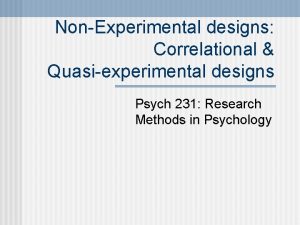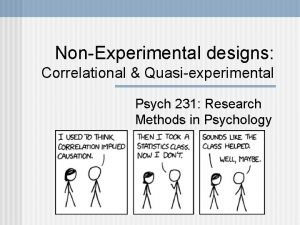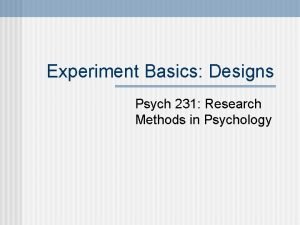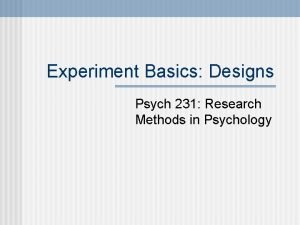Experimental Design Single factor designs Psych 231 Research
























- Slides: 24

Experimental Design: Single factor designs Psych 231: Research Methods in Psychology

Announcements n Reminder: your group project experiment Methods section (& Appendix) and IRB protocol are due in labs this week

Poorly designed experiments n Bad design example 1: Does standing close to somebody cause them to move? n n n “hmm… that’s an empirical question. Let’s see what happens if …” So you stand closely to people and see how long before they move Problem: no control group to establish the comparison group (this design is sometimes called “one-shot case study design”)

Single variable – One Factor designs n 1 Factor (Independent variable), two levels n n Basically you want to compare two treatments (conditions) The statistics are pretty easy, a t-test Observed difference btwn conditions T-test = Difference expected by chance n Although there are several types of t-tests • Depends on your design

Poorly designed experiments n Bad design example 2: n n Testing the effectiveness of a stop smoking relaxation program The subjects choose which group (relaxation or no program) to be in

Problem: selection bias for the two groups, need to do random assignment to groups Poorly designed experiments n Non-equivalent control groups Self Independent Assignment Variable Dependent Variable Training group Measure No training (Control) group Measure participants Random Assignment

Poorly designed experiments n Bad design example 3: Does a relaxation program decrease the urge to smoke? n Pretest desire level – give relaxation program – posttest desire to smoke

Poorly designed experiments n One group pretest-posttest design Dependent Variable participants Add another factor Independent Variable Pre-test Training group Dependent Variable Post-test Measure Pre-test No Training group Post-test Measure Problems include: history, maturation, testing, and more

1 factor - 2 levels n Good design example n How does anxiety level affect test performance? • Two groups take the same test • Grp 1 (moderate anxiety group): 5 min lecture on the importance of good grades for success • Grp 2 (low anxiety group): 5 min lecture on how good grades don’t matter, just trying is good enough

1 factor - 2 levels Random Assignment Anxiety Dependent Variable Low Test Moderate Test participants

Single variable – one Factor anxiety low moderate 60 80 test performance One factor Use a t-test to see if these points are statistically different low Two levels moderate anxiety

Single variable – one Factor n Advantages: n n Simple, relatively easy to interpret the results Is the independent variable worth studying? • If no effect, then usually don’t bother with a more complex design n Sometimes two levels is all you need • One theory predicts one pattern and another predicts a different pattern

Single variable – one Factor n Disadvantages: n “True” shape of the function is hard to see • interpolation and extrapolation are not a good idea

Interpolation test performance What happens within of the ranges that you test? low moderate anxiety

Extrapolation test performance What happens outside of the ranges that you test? low moderate anxiety high

1 Factor - multilevel experiments n n For more complex theories you will typically need more complex designs (more than two levels of one IV) 1 factor - more than two levels n n Basically you want to compare more than two conditions The statistics are a little more difficult, an ANOVA (Analysis of Variance)

1 Factor - multilevel experiments n Good design example (similar to earlier ex. ) n How does anxiety level affect test performance? • Two groups take the same test • Grp 1 (moderate anxiety group): 5 min lecture on the importance of good grades for success • Grp 2 (low anxiety group): 5 min lecture on how good grades don’t matter, just trying is good enough • Grp 3 (high anxiety group): 5 min lecture on how the students must pass this test to pass the course

1 factor - 3 levels Random Assignment participants Anxiety Dependent Variable Low Test Moderate Test High Test

anxiety low mod high 60 80 60 test performance 1 Factor - multilevel experiments low mod anxiety high

1 Factor - multilevel experiments n Advantages n n Gives a better picture of the relationship (function) Generally, the more levels you have, the less you have to worry about your range of the independent variable

Relationship between Anxiety and Performance 2 levels test performance 3 levels low moderate anxiety low mod anxiety high

1 Factor - multilevel experiments n Disadvantages n n Needs more resources (participants and/or stimuli) Requires more complex statistical analysis (analysis of variance and pair-wise comparisons)

Pair-wise comparisons n The ANOVA just tells you that not all of the groups are equal. n If this is your conclusion (you get a “significant ANOVA”) then you should do further tests to see where the differences are • High vs. Low • High vs. Moderate • Low vs. Moderate

Next time n n Adding a wrinkle: between-groups versus within -groups factors Read chapter 11
 Single factor design
Single factor design Quasi-experimental research designs
Quasi-experimental research designs Quasi-experimental research designs
Quasi-experimental research designs Disadvantages of experimental research
Disadvantages of experimental research Experimental vs nonexperimental
Experimental vs nonexperimental Principles of experimental design
Principles of experimental design Matched-pair design
Matched-pair design Design meaning in research
Design meaning in research Basic principles of experimental design
Basic principles of experimental design Research instrument in experimental research
Research instrument in experimental research Research instrument in experimental research
Research instrument in experimental research Experimental vs non experimental
Experimental vs non experimental Experimental research design types
Experimental research design types Experimental vs non experimental
Experimental vs non experimental Characteristics of experimental research design
Characteristics of experimental research design Non experimental research topics
Non experimental research topics Quasi experiment disadvantages
Quasi experiment disadvantages Non experimental research correlational design
Non experimental research correlational design Random assignment vs selection
Random assignment vs selection Case control vs retrospective cohort
Case control vs retrospective cohort The experiment chapter three
The experiment chapter three Experimental research design types
Experimental research design types Analyzing and interpreting data in research
Analyzing and interpreting data in research Single factor design
Single factor design Single factor design
Single factor design













































